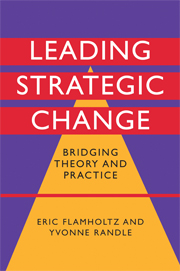Book contents
- Frontmatter
- Contents
- List of exhibits
- Preface
- Acknowledgments
- Part I An integrative framework for leading strategic and organizational change
- Part II Leading strategic change in actual organizations
- 4 Leading strategic and organizational change at Countrywide Financial Corporation
- 5 Leading change at Starbucks Coffee Company
- 6 Strategic marketing through HR interventions: a case study of Indian Oil Corporation
- 7 The evolution of Stan Tashman and Associates
- 8 Leading strategic and organizational change at IndyMac Bank
- 9 Leading strategic and organizational change at Infogix
- 10 Leading strategic and organizational change: the transformation of structure at Pardee Homes
- 11 Leading strategic and organizational change at Tata Steel: the role of culture
- 12 Leading strategic and organizational change at Westfield: transformation to a global enterprise
- Part III Leading strategic change: lessons learned from practice
- Appendix: References for further reading on leading change
- Index
11 - Leading strategic and organizational change at Tata Steel: the role of culture
from Part II - Leading strategic change in actual organizations
Published online by Cambridge University Press: 22 September 2009
- Frontmatter
- Contents
- List of exhibits
- Preface
- Acknowledgments
- Part I An integrative framework for leading strategic and organizational change
- Part II Leading strategic change in actual organizations
- 4 Leading strategic and organizational change at Countrywide Financial Corporation
- 5 Leading change at Starbucks Coffee Company
- 6 Strategic marketing through HR interventions: a case study of Indian Oil Corporation
- 7 The evolution of Stan Tashman and Associates
- 8 Leading strategic and organizational change at IndyMac Bank
- 9 Leading strategic and organizational change at Infogix
- 10 Leading strategic and organizational change: the transformation of structure at Pardee Homes
- 11 Leading strategic and organizational change at Tata Steel: the role of culture
- 12 Leading strategic and organizational change at Westfield: transformation to a global enterprise
- Part III Leading strategic change: lessons learned from practice
- Appendix: References for further reading on leading change
- Index
Summary
Introduction
The Tata Group is one of India's most successful and prestigious business groups. Tata Steel is one of the key components of the group and one of the most important companies in India.
From its founding until the early 1990s Tata Steel was a classic paternalistic employer. This was facilitated by economic conditions that made India a producer's or seller's market. There was an environment of scarcity, and people would be forced to wait until something was produced. This was not an environment conducive to competition or efficiency. It allowed Tata to take care of its employees, but not to be a highly efficient competitive organization.
During the 1990s the winds of change swept into India. Tata Steel was forced to change its way of doing business in order to adapt to the new era of competition. By the early 1990s Tata's technology had become so outdated that the then Managing Director, Dr. Irani, would joke that if they did not change their technology they may as well convert Tata Steel to a museum of steel-making history!
This chapter deals with the initial development and, later, the strategic and organizational changes at Tata Steel in response to this environmental change. The particular focus of this chapter is on the need to transition from a very paternalistic culture (in which employees are cared for like family) to one that is still humanistic but is now more efficient and competitive and focused on the needs of all its stakeholders, including investors.
- Type
- Chapter
- Information
- Leading Strategic ChangeBridging Theory and Practice, pp. 188 - 204Publisher: Cambridge University PressPrint publication year: 2008



